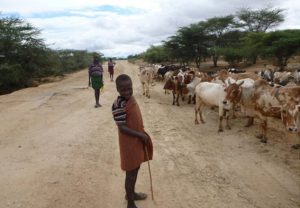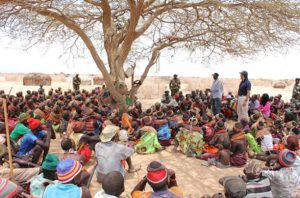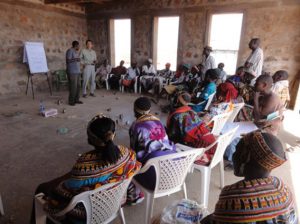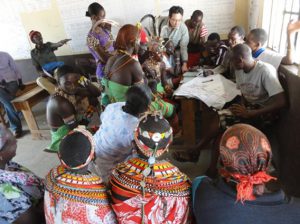#drought #livestock #pastoralist
Empowering communities to take their own initiative to reduce risks of drought
Project Summary
“During my grandfather’s time, drought occurred once every 20 years. During Father’s time, it occurred once every 10 years. Now, it occurs once every 3 to 5 years.”
Due to the effect of climate change, traditional lifestyle of local people in Northern Kenya is threatened.
-
Traditional welcome dance of the Rendille tribe performed in the project site
Source: https://www.jica.go.jp/oda/project/1103656/index.html
-
A reservoir for livestock
Source: https://libopac.jica.go.jp/images/report/12246914.pdf
Generally, the northern part of Kenya has four seasons: short rainy, long rainy, short dry and long dry. In a normal year, the long dry season lasts for about six months and for pastoralists, it is not drought as long as it rains at the end of the season. However, if it does not rain in the following short rainy season, the dry period may extend up to 11 months (so-called single-year drought). If the dry season lasts for more than two rainy seasons, it is considered as multiyear drought, and the livelihood condition of residents becomes severe. Since rainfall is unpredictable, local people cannot forecast how many months or years a drought may last. And when they realise that a severe drought has arrived, it is already too late to prepare for it.
Aiming to strengthen resilience against drought of local pastoralists, semi-settled and settled people, the Government of Kenya implemented “The Project for Enhancing Community Resilience against Drought in Northern Kenya” or ECoRAD Project from 2012 to 2015 with the support from Japan International Cooperation Agency (JICA).
Project Details
Typical cause of livestock death during drought in Northern Kenya
-
A pastoralist grazing his livestock
Source: https://www.jica.go.jp/oda/project/1103656/index.html
-
Local people gathered for baseline survey of the project
Source: https://www.jica.go.jp/oda/project/1103656/index.html
The target area of ECoRAd comprised of Marsabit and Turkana Counties in Northern Kenya. These two counties have similar rainfall patterns with short/long rainy seasons and short/long dry seasons. During rainy reason, herders tend to keep livestock near their village. When the rainy season is over and the dry season comes, they start to move to the dry season grazing area where pastures and water are available. If pasture or water is exhausted in the first grazing area, they move to the next grazing area. When the dry season is over, herders take back the livestock to their home village, and they stay there for the whole rainy season.
In a normal year, herders lead livestock back to their home village before the dry season grazing areas are exhausted. However, if it does not rain at the end of the dry season and drought starts, the herders then move their livestock to the next grazing area as long as they have a next place to go. However, if they do not have anywhere to go due to physical or territorial limitation, livestock start to die due to lack of fodder and this also triggers conflict with adjacent ethnic group. This is the occurrence of livestock death in a typical drought case.
Purpose and target area of the project
The purpose of the ECoRAD Project was to enhance the pastoralist communities’ resilience to drought in Marsabit and Turukana Counties. Twenty pilot communities were selected from these counties comprising the target area. There were three main technical components of the ECoRAD Project: Sustainable Natural Resource Management, Improvement of Livestock Value Chain and Livelihood Diversification. In addition, capacity development of government officers was also included in the project scheme. The schematic diagram of the project is shown in Figure 1.

Source: https://libopac.jica.go.jp/images/report/12246914.pdf
Figure 1: The schematic diagram of the ECoRAD Project
Empowering communities to take their own initiative to reduce risks associated with disasters
Local people attending seminar on Community Managed Disaster Risk Reduction (CMDRR) Approach
The ECoRAD Project adopted Community Managed Disaster Risk Reduction (CMDRR) Approach, a process in which a community is actively engaged in identifying, analysing and evaluating disaster risks with the aim of reducing people’s vulnerability and enhancing their capacities. In a CMDRR process, communities are facilitated and assisted to carry out disaster risk assessment, draw a disaster risk reduction strategy, and prepare a Disaster Risk Reduction Community Action Plan. In addition, as subprojects under the three major components, various small projects were implemented such as borehole/water pan construction, sand dam rehabilitation, construction and upgrading of livestock markets, goat merry-go-round project, and honey business project.
For more information, check the manuals/reports
The technical training manuals are available from the links below. These may be applied to other countries in arid/semi-arid areas.
・[ENG] Final Report of the Project for Enhancing Community Resilience against Drought in Northern Kenya Vol.1
・[ENG] Final Report of the Project for Enhancing Community Resilience against Drought in Northern Kenya Vol.2
・[ENG] Final Report of the Project for Enhancing Community Resilience against Drought in Northern Kenya Vol.3
Written by Ayaha MOCHIZUKI,
AI-CD Secretariat Support Team








